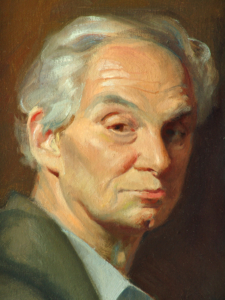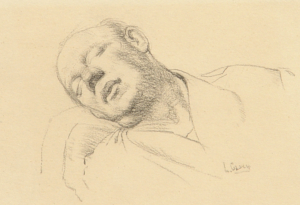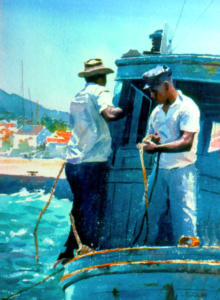About Larry Gluck
Lawrence Jerrold Gluck was born to Maurice and Jane Gluck, a pharmacist and homemaker, on April 9, 1931. It was in a modest home among the sycamore and maple studded suburbs of Queens, New York, that Larry would have, as he puts it, his first “aesthetic experience.”
When his Father had come home after a hard day’s work, and Larry and his older brother Michael had been put to bed, enchanting music would drift through the house. Larry was inescapably drawn to the magic.
Sneaking downstairs, he would tip-toe into the living room and hide behind the sofa. As he peered over an armrest, there would be Dad pouring his heart out over the piano keys. The man was a natural who played by ear; the notes spontaneously flowed from his fingers. And so began Larry’s love of creativity.
It wasn’t long before he climbed onto the stool himself, and by age six was taking piano lessons from Mrs. Stamm at fifty cents a pop. Music, however, wasn’t the only feather in Larry’s creative cap. He can’t remember the first time he put pencil to paper, but what is certain is that Larry was drawing and sketching from a very early age. Unlike piano, this was something he didn’t have to learn. The lines and shapes seemed to draw themselves.
Family and friends who frequented the Gluck’s often found young Larry sitting quietly in a corner sketching. When asked to show what he had drawn, he’d flip the sketch pad around and surprise them: instead of the expected stick figures, Larry had drawn their portrait. And if there’s any question as to how adept those portraits were, it wasn’t uncommon for visitors to take his works home and have them framed.
By age thirteen, he was studying under the Italian portrait master Giuseppe Trotta, an old classmate of Picasso himself. For three solid years Larry worked under the eccentric master. Trotta had an uncanny ability to bring someone to life on canvas and passed much of his wisdom on to the young apprentice. During these formative years, Larry was inspired to become a portrait painter in earnest.
After graduating high school, Larry pursued his dream by attending the nation’s most prestigious art school. He found, however, an institution more dedicated to modern fads and abstract theories than to fine art. The classical, “representational” art that had pervaded civilization and inspired culture for thousands of years was now deemed irrelevant, defunct… passé. Worse, those who could draw or represent the “real world” were considered unimaginative bores; not true artists at all, but illustrators at best. He soon gave up on the idea that he could succeed as an artist.
Things could hardly have been worse – that is, until a fateful telegram arrived informing him that he had been drafted. Those familiar with history know the Korean War was a particularly bloody affair. Some 37,000 Americans died, while there were 4,000,000 civilian and military casualties on both sides. This was the scene that twenty year old Larry Gluck was about to step into.
Larry was put in charge of the 8069th Replacement Depot’s paint shop and oversaw the production of signs for the Army. But his duties extended further: every night a black Lincoln would roll up to the barracks and collect Private Gluck. This wasn’t any old Lincoln. This was the U.S. Ambassador’s personal chauffeur-driven limo, replete with little fluttering flags on the hood. Its destination: the Pusan Club, the most exclusive nightspot on the Korean Peninsula. And so he spent his nights, entertaining the military’s top brass.
Returning home, the next several years proved restless. After earning a Bachelor of Arts degree at Adelphi College, there was a brief stint as an Assistant Art Director for the largest fashion advertising agency in New York, followed by work as a freelance advertising designer on Madison Avenue. It was during this time that Larry met the woman who would become the love of his life, a young and striking Sheila Baws.
They were soon married, and in 1961 on a well-deserved vacation to the U.S. Virgin Islands, Larry and Sheila fell for the Caribbean paradise of Saint Thomas. It was a welcome change from the hectic city. As Sheila put it, “We became discontented with the prospect of a split-level home on Long Island, which seemed to be our impending future.” Permanently reshaping that future, they settled on Saint Thomas and planned to buy the Black Patch, a popular nightspot on the island. But when the owners decided not to sell, Larry and Sheila were left to fend for themselves.

Sheila & Larry Gluck
Perhaps it was a godsend, because out of necessity, Larry picked up a brush and set his easel in the sand. His subject: the islands themselves, and in terms of medium, Larry explained, “it was only watercolor with its intrinsic beauty of transparency and pure color that could capture the radiance and excitement of St. Thomas.”
It wasn’t long before the radiance and excitement expressed through his work caught the eye of locals and visitors alike. First came a commission from the Virgin Isle Hilton, then from Bluebeard’s Castle to provide tropical landscapes for all their rooms. Incidentally, so many of his originals mysteriously went missing after guests checked out that hotel managers were forced to bolt his work to the walls.
Larry followed by displaying his work in restaurants, clubs and hotels across the islands. Within the first year, more than six hundred new collectors had acquired his works.
His renown spread to the United States and Europe, and by 1970, 3,500 paintings hung throughout the world—from the private collections of Charles Revson (the founder of Revlon Cosmetics) to the Danish Royal Family.
Larry became a local celebrity, with tourists literally posing outside his mountainside home for snapshots. The Gluck name was also widely repeated on a national scale, in the pages of the New York Herald Tribune, and on the airwaves, with interviews broadcast on CBS and NBC.
As Larry was growing in renown he was also growing as an artist. Returning to oils, he developed a wholly new and original style, “Mirage D’ Esprit” truly unique paintings which appear simply as a pure field of color, but upon further examination, a face emerges, or a beautiful nude… like spirits alighting from the canvas. Hard to capture in words and even harder to successfully photograph, they are among Larry’s most sought after creations. Ironically, if Larry had learned anything in art school, it was that he couldn’t succeed as a representational painter; and here he was, living with more success than he’d ever dreamed possible… a success he wanted to pass on to others.
And so, along with their two children, Larry and Sheila relocated to Los Angeles, and in 1975, opened their own art school, Mission: Renaissance.
Classes began in their home on Mount Washington. By word of mouth and Sheila’s efforts, they packed their house with 100 students a week. The most unforgettable of these students was a man with a passionate desire to paint, but who possessed absolutely no natural talent. Larry struggled to teach him, but again and again the eager novice blundered and made no progress. Others would have labeled him hopeless, but Larry persisted. He was forced to examine the art of drawing and painting more closely than he’d ever done before.
“Perhaps no one has enabled so many to acquire artistic talent as has Larry Gluck. His breakthroughs in fine art training have led to success and artistic fulfillment for countless thousands of all ages and from all walks of life.”
A seemingly obvious first step, and yet a step that, once applied, unlocked this student’s ability. It was a crucial turning point. Here was proof that anyone could learn to draw and paint, that talent could be acquired. And here was the seed that was to later become what we know today as The Gluck Method. Larry pioneered the first complete step-by-step fine art program, isolating and codifying the principles of drawing and painting.
Through the course of his teaching, he came across many a student who had attended art school, but who had graduated with gaping holes in their art education. It became all too evident that art institutions had abandoned traditional principles—the same principles that were the backbone of the Renaissance, the very same principles taught to the great masters throughout history.
Larry dedicated himself to unearthing and imparting this lost knowledge, but accomplished something unprecedented in the history of art education. Using his revolutionary method, not only did students with natural talent succeed, but students who considered themselves devoid of any talent were equally successful and became competent artists. Perhaps that one unique factor made Mission: Renaissance what it is today: the largest fine art program in the world.
Any artist worthy of note passes on his hard-won wisdom to an apprentice or two, but in the case of Larry Gluck, thanks to all he has set forth, his apprentices truly number in the tens of thousands. A once forbidden world is now open to all—a world where anyone is free to create and express themselves, to celebrate the glory and beauty of life through art.
Larry pioneered the first complete step-by-step fine art program, isolating and codifying the principles of drawing and painting – The Gluck Method of Fine Art Instruction.




